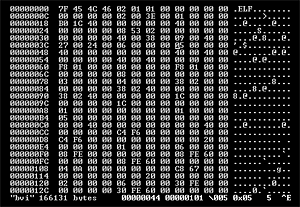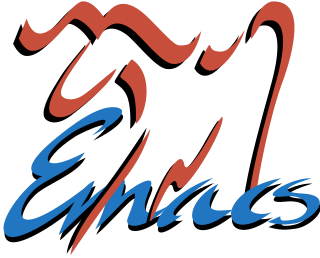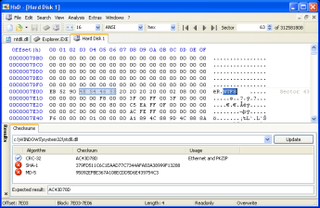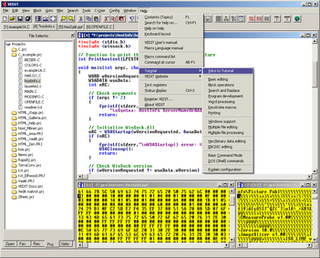 W
W010 Editor is a commercial hex editor and text editor for Microsoft Windows, Linux and macOS. Typically 010 Editor is used to edit text files, binary files, hard drives, processes, tagged data, source code, shell scripts, log files, etc. A large variety of binary data formats can be edited through the use of Binary Templates.
 W
WBEYE is a multiplatform, portable viewer of binary files with a built-in editor that functions in binary, hexadecimal and disassembler modes. It uses native Intel syntax for disassembly. Features include an AVR/Java/x86-i386-AMD64/ARM-XScale/PPC64 disassemblers, a Russian code pages converter, full preview of MZ, NE, PE, NLM, COFF32, ELF formats, partial preview of a.out, LE and LX, Phar Lap formats, and a code navigator.
 W
Wbvi is a screen-oriented computer program used to edit binary files. It is based on the vi text editor, and can run on most UNIX-like platforms and on DOS/Windows. bvi was written by Gerhard Bürgmann and is published under the GNU General Public License.
 W
WEmacs or EMACS is a family of text editors that are characterized by their extensibility. The manual for the most widely used variant, GNU Emacs, describes it as "the extensible, customizable, self-documenting, real-time display editor". Development of the first Emacs began in the mid-1970s, and work on its direct descendant, GNU Emacs, continues actively as of 2020.
 W
WGNU Emacs is a free software text editor. It was created by GNU Project founder Richard Stallman. In common with other varieties of Emacs, GNU Emacs is extensible using a Turing complete programming language. GNU Emacs has been called "the most powerful text editor available today". With proper support from the underlying system, GNU Emacs is able to display files in multiple character sets, and has been able to simultaneously display most human languages since at least 1999. Throughout its history, GNU Emacs has been a central component of the GNU project, and a flagship of the free software movement. GNU Emacs is sometimes abbreviated as GNUMACS, especially to differentiate it from other EMACS variants. The tag line for GNU Emacs is "the extensible self-documenting text editor".
 W
WGNU Emacs is a free software text editor. It was created by GNU Project founder Richard Stallman. In common with other varieties of Emacs, GNU Emacs is extensible using a Turing complete programming language. GNU Emacs has been called "the most powerful text editor available today". With proper support from the underlying system, GNU Emacs is able to display files in multiple character sets, and has been able to simultaneously display most human languages since at least 1999. Throughout its history, GNU Emacs has been a central component of the GNU project, and a flagship of the free software movement. GNU Emacs is sometimes abbreviated as GNUMACS, especially to differentiate it from other EMACS variants. The tag line for GNU Emacs is "the extensible self-documenting text editor".
 W
WFlexHex is a freeware hex editor for Microsoft Windows that can edit files, NTFS alternate streams and sparse data, OLE compound files, logical disks, and physical drives.
 W
WHxD is a hex editor, disk editor, and memory editor developed by Maël Hörz for Windows. It can open files larger than 4 GiB and open and edit the raw contents of disk drives, as well as display and edit the memory used by running processes. Among other features, it can calculate various checksums, compare files, or shred files.
 W
WThe Unified Code Counter (UCC) is a comprehensive software lines of code counter produced by the USC Center for Systems and Software Engineering. It is available to the general public as open source code and can be compiled with any standard ANSI C++ compiler.
 W
WVedit is a commercial text editor for 8080/Z-80-based systems, Microsoft Windows and MS-DOS from Greenview Data, Inc.
 W
WVim is a clone, with additions, of Bill Joy's vi text editor program for Unix. Vim's author, Bram Moolenaar, based it on the source code for a port of the Stevie editor to the Amiga and released a version to the public in 1991. Vim is designed for use both from a command-line interface and as a standalone application in a graphical user interface. Vim is free and open-source software and is released under a license that includes some charityware clauses, encouraging users who enjoy the software to consider donating to children in Uganda. The license is compatible with the GNU General Public License through a special clause allowing distribution of modified copies "under the GNU GPL version 2 or any later version".